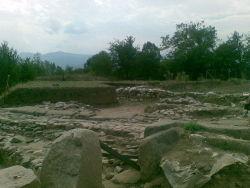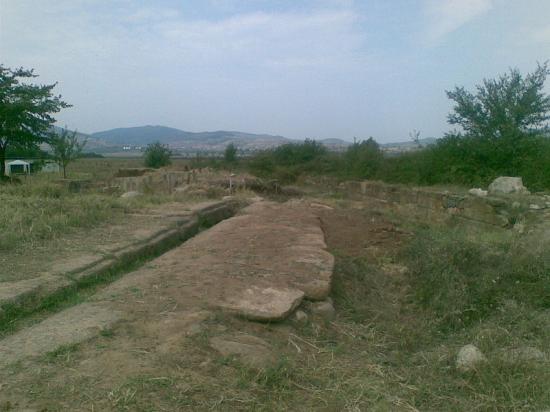Source - http://popular-archaeology.com/issue/december-2012/article/archaeologists-excavate-ancient-greek-trade-center-in-bulgaria
This Greek emporion thrived under the kings of ancient Thrace.

Excavated remains of the wharf at Pistiros. Wikimedia Commons
Archaeologist and professor Mieczysław Domaradzki likely made one of the great discoveries of his life when, in 1990, he and his colleagues uncovered, at a site along the banks of the Maritsa River in Bulgaria, an ancient stone Greek inscription. The inscription, today known as theVetren Inscription (named after the nearby town of Vetren), revealed the site as the location of the ancient Greek trading center, or emporion, of Pistiros.
But the inscription revealed more than this. It afforded a rare glimpse into the special relationship that the Pistiros Greeks had with their Thracian hosts, as Pistiros sat deep within the territory of the 5th - 3rd century B.C. Thracian Odryssian kings:
If a merchant brings suit against another merchant (in Pistiros) they shall be judged among their kinsmen and with regard to whatever is owed to the merchants by Thracians, there shall be no cancellation of these debts. All land and pasture owned by the merchants shall not be taken away from them. He shall not send holders of estates(?) to the merchants. He shall not install a garrison at Pistiros nor will he transfer Pistiros to another. He shall not exchange the land lots of the Pistirians nor transfer them to another. Neither he nor members of his family shall seize the property of the merchants. He shall not levy road taxes on any goods exported by the merchants from Pistiros to Maronea of from Maronea to Pistiros or to the market place Belana of the Praseoi. The merchants shall open and close their wagons. Just as also in the time of Cotys [I swear this oath]; Neither I nor anyone of my family will blind or kill a citizen of Maronea; Nor shall i or any member of my family seize the property of a citizen of Maronea, whether he be alive or dead; Nor shall I nor anyone of my family blind or kill a citizen of Apollonia or Thasos who is living in Pistiros whether he is alive or dead..........
It was all about economy, and ancient Greece and Thrace at this time enjoyed a mutually beneficial relationship that boosted the wealth of both civilizations and sustained political expediency on both sides.
Now, a team of archaeologists, students and volunteers under the direction of Assistant Professor Alexey Gotsev of the National Institute of Archaeology and Museum, Bulgarian Academy of Sciences, are continuing excavations and research at the ancient site, revealing the vestiges of a thriving community of merchants who lived behind monumental fortifications, walked along well-paved streets, and owned finely-crafted Greek ware. Reports the project leadership: "Merchants from Greek coastal cities of Maroneia, Thassos and Apollonia lived and traded there with their Thracian neighbours under the supreme protection of the Thracian Odryssian kings. The emporion was also a major metallurgical centre and a key harbour for export of metals and metal products from Thrace to Greece in the Classical and Early Hellenistic periods."[1] Among the key finds of the excavations were, in addition to the architectural finds, Attic red-figured and black-glazed pottery, amphorae, and coins of different Odryssean kings (e.g. Amatokos I, Bergaios, Kotys I, Amatokos II, Teres II, Kersebleptes, Teres II), Greek cities (Thasos, Maroneia, Parion, Thracian Chersonese, Kypsela, Enos, Apollonia, Messabria etc.) and Macedonian rulers (Philip II, Alexander the Great, Kassandros, Demetrios Poliokretes, Lysimachos etc.). Excavations have revealed the Eastern fortification wall of the emporion, which featured a gate, a bastion and several towers constructed of stone blocks and built in the style typical of the builders of the Greek inhabitants of Thassos. Other finds included streets paved with stone plates, the stone foundations of buildings and a drainage system.

Excavated walls of ancient Pistiros. Wikimedia Commons
A key research question being investigated by the archaeologists revolves around the nature and extent of the cults practiced at Pistiros, especially that of Dionysos, the son of Zeus and the god of wine and madness, vegetation, and the theatre. "It played a very important role in the emporion’s religious life," reports the project leadership. "For instance, the Vetren Inscription informs about the oath taken in the name of Dionysos by the Odryssian king Kotys I and his successors about the citizens of Pistiros - this is how they [the merchants and inhabitants of Pistiros] guaranteed the integrity of their lives, properties and activities in their town under the sovereignty of the Thracian kings." [1]
In 2013, archaeologists hope to explore the southeast sector of the site focusing on an area near the fortification wall that may hold more evidence of cult-related artifacts and features; the central area of the site, which may contain features and artifacts representing the earlier periods of the emporion; and areas outside of the fortification wall which may shed some light on settlement beyond the central area.
Excavations and a field school are conducted under the auspices of the Balkan Heritage Foundation, National Archaeological Institute with the Museum at the Bulgarian Academy of Sciences, the “Prof. Mieczyslaw Domaradzki” Archaeological Museum in Septemvri, the New Bulgarian University (Bulgaria); the “Pistiros” Association; the University of Liverpool (England); and the Charles University in Prague (Czech Republic).
More information about the project and how to participate can be obtained at the Balkan Heritage Field School website.
[1] http://www.bhfieldschool.org/bh2013pistiros.html